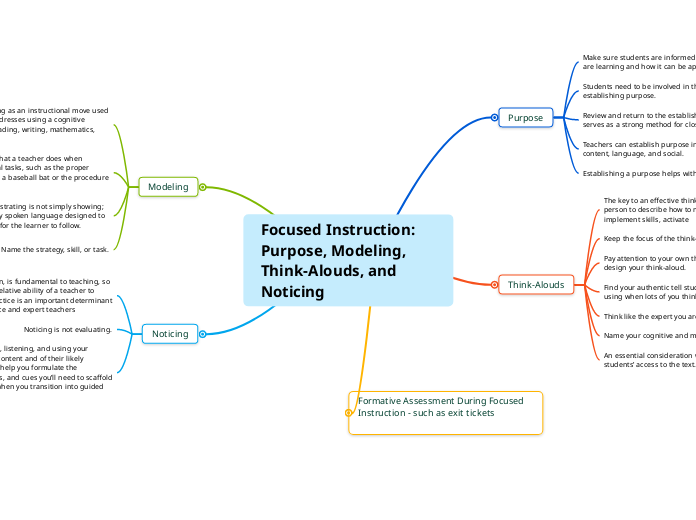Focused Instruction: Purpose, Modeling, Think-Alouds, and Noticing
Purpose
Make sure students are informed about what they are learning and how it can be applied to them.
Students need to be involved in the process of establishing purpose.
Review and return to the established purpose, this serves as a strong method for closing the lesson.
Teachers can establish purpose in three domains: content, language, and social.
Establishing a purpose helps with motivation.
Think-Alouds
The key to an effective think-aloud is to use the first person to describe how to make decisions, implement skills, activate
Keep the focus of the think-aloud brief.
Pay attention to your own thinking processes as you design your think-aloud.
Find your authentic tell students information, voice using when lots of you think aloud.
Think like the expert you are.
Name your cognitive and metacognitive processes.
An essential consideration with this approach is the students’ access to the text. PHYSICAL TEXT>
Formative Assessment During Focused Instruction - such as exit tickets
Modeling
We think of modeling as an instructional move used when the lesson addresses using a cognitive process, such as reading, writing, mathematics, and such.
Demonstrating is what a teacher does when focusing on physical tasks, such as the proper stance for swinging a baseball bat or the procedure for turning on
Modeling or demonstrating is not simply showing; it is accompanied by spoken language designed to provide a narrative for the learner to follow.
Step 1. Name the strategy, skill, or task.
Step 2. State the purpose of the strategy, skill, or task.
Step 3. Explain when the strategy or skill is used.
Step 4. Use analogies to link prior knowledge to new learning.
Step 5. Demonstrate how the skill, strategy, or task is completed.
Step 6. Alert learners about errors to avoid.
Step 7. Assess the use of the skill.
Noticing
Focused instruction, is fundamental to teaching, so much so that the relative ability of a teacher to engage in this practice is an important determinant in identifying novice and expert teachers
Noticing is not evaluating.
You are observing, listening, and using your knowledge of the content and of their likely misconceptions to help you formulate the questions, prompts, and cues you’ll need to scaffold student learning when you transition into guided instruction.
